Golf is a sport enjoyed by people of all ages and skill levels. However, golf also comes with injury risks from overuse and acute traumatic events. Understanding the most common injuries in golf and how to prevent them can help golfers play the game safely for many years. Golf swing exercises can be learned to reduce injuries.
What causes golfer's elbow?
Golfer’s elbow is typically caused by repetitive motions, such as swinging a golf club, which strain the tendons in the inner side of the elbow.
How can back strain be prevented in golf?
Back strain in golf can be prevented by maintaining proper posture, warming up before playing, using correct swing techniques, and incorporating core-strengthening exercises into a regular fitness routine.
What are some measures to prevent wrist tendinitis in golf?
To prevent wrist tendinitis, golfers can use proper grip techniques, ensure their equipment fits well, and avoid overuse by taking regular breaks during practice or play.
What can golfers do to prevent knee injuries?
Golfers can prevent knee injuries by using proper footwear with good support, maintaining overall fitness and flexibility, and avoiding excessive stress on the knees during swings and movements.
How can hand and finger injuries be minimized in golf?
Golfers can minimize hand and finger injuries by using properly fitting gloves, practicing good grip technique, and avoiding overexertion or strain on the hands during swings.
Common injuries in golf
1. Overuse injuries
Many common golf injuries are due to overuse from the repetitive motions of the golf swing. These include:
Back injuries
Golfers are prone to various back injuries due to the repetitive motions and torques involved in the swing.
Disc herniations and bulges:
The golf swing involves twisting and spine rotation that can stress the discs between the vertebrae. Over time, this repetitive stress can lead to the discs bulging or herniating, putting pressure on the spinal nerves and causing pain. Early signs include pain in the lower back radiating down the legs.
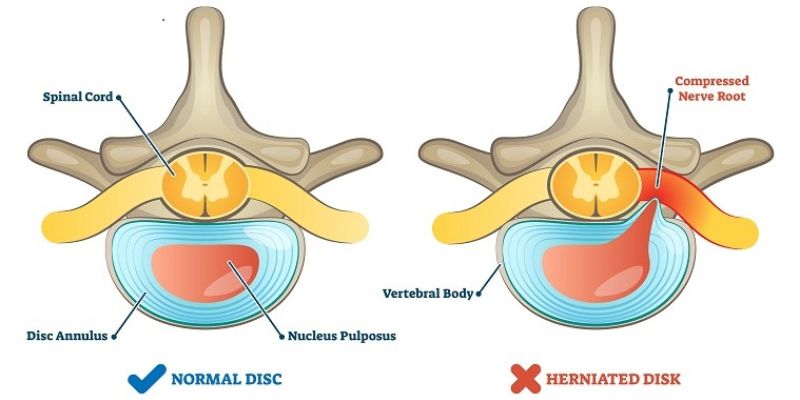
Muscle strains:
The bending and lifting involved in golf – from picking up balls to alignment sticks – can strain the lower back muscles. That includes the erector spinae muscles alongside the spine and the abdominal muscles. Muscle strains cause pain, spasms, and difficulty moving the back through a full range of motion.
Prevention involves:
- Strength training for the core and back muscles.
- Proper warm-up.
- Stretching after 18 holes.
- Modifying the swing to reduce spinal rotation and loading when symptoms first appear.
Chiropractic care, anti-inflammatory medications, and physical therapy can help rehabilitate back injuries.
Elbow injuries
Golfers can develop elbow tendinitis and injury from overusing the forearm muscles that control the wrist during the swing.
Golfer’s elbow refers to medial epicondylitis, caused by overuse of the wrist flexor muscles that originate on the medial epicondyle of the elbow. The repetitive gripping and wrist flexion during the swing can lead to inflammation and pain on the inner side of the elbow. Golf injuries elbow symptoms include tenderness over the medial epicondyle and pain with wrist flexion and gripping movements.

Tennis elbow
Lateral epicondylitis is caused by overuse of the wrist extensor muscles that attach to the lateral epicondyle. The same repetitive wrist motions in the golf swing cause microtears and inflammation, resulting in pain on the outer side of the elbow. Symptoms include tenderness over the lateral epicondyle and pain with wrist extension movements.
Treatment for both types of tendinitis focuses on reducing inflammation, modifying the swing to reduce wrist stress, and physical therapy to strengthen the forearm muscles. Elbow straps and braces can provide support and compression during golf activities.
Cortisone injections and surgery are options for chronic cases that don’t improve with more conservative measures. With proper treatment and swing modifications, elbow tendinitis can often be managed to enable golfers to return to playing the sport.
Wrist injuries
The repetitive gripping and wrist motions involved in the golf swing can lead to inflammation and golf injuries wrist tendons and ligaments.

Tendinitis:
Golfers often develop tendinitis from overuse of the extensor carpi ulnaris and flexor carpi ulnaris tendons on the outer and inner sides of the wrist. The constant gripping and cocking of the wrist during the swing apply stress to these tendons, causing inflammation and pain. Symptoms include pain, tenderness, and stiffness in the wrists, especially with gripping the golf club. Wrist range of motion may be reduced.
Sprains:
Twisting movements in the golf swing can also sprain or strain the ligaments that stabilize the wrist joint. This causes pain, swelling, and instability in the wrist. Treatment focuses on reducing wrist stress during golf, along with nonsteroidal anti-inflammatory drugs, wrist splints, and physical therapy to address weakness and mobility issues.
Prevention methods include:
- Taking breaks between rounds of golf
- Using longer grips or specialized gloves that reduce wrist bending
- Modifying the swing to reduce wrist cocking
- Strengthening the forearm muscles to better support the wrists
With appropriate rest, medication, and modification of their swings and grips, most golfers can effectively manage and reduce common injuries in golf like wrist tendinitis and sprains to return to playing the sport. Over time, strengthening exercises can help build tolerance and endurance to minimize the risk of recurrent wrist injuries.
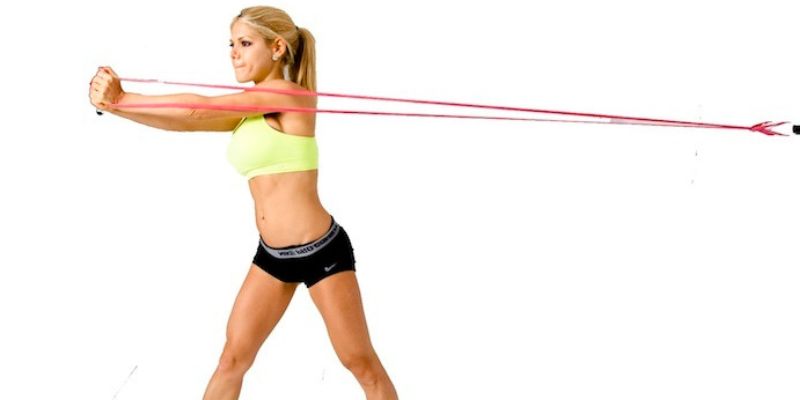
2. Traumatic Injuries
Golfers are prone to overuse and acute traumatic injuries, especially in the shoulders, knees, and ankles.
Shoulder injuries
Rotator cuff tears are a common golf injury, particularly in older golfers. The rotator cuff is a group of four tendons that stabilize the shoulder joint. During the acceleration phase of the golf swing, the rotator cuff tendons must eccentrically contract to control and decelerate the arm. Over time, this repeated high load can damage the tendons, leading to fraying, partial, and full-thickness tears.
Symptoms of golf injuries shoulder include shoulder pain that worsens with swinging, weakness, and loss of range of motion. Tears can range from mild to severe, requiring prolonged rehabilitation or even surgery to repair the damage. Prevention focuses on proper swing mechanics to minimize excessive shoulder rotation, regular stretching, and strengthening of the rotator cuff muscles.
Knee injuries
ACL tears frequently occur in golf due to sudden stops, direction changes, and twists while playing – especially around the green. The anterior cruciate ligament (ACL) provides knee stability by connecting the thigh to the shin bone. ACL injuries in golf most commonly happen during an off-balanced swing or pivoting during a putt.
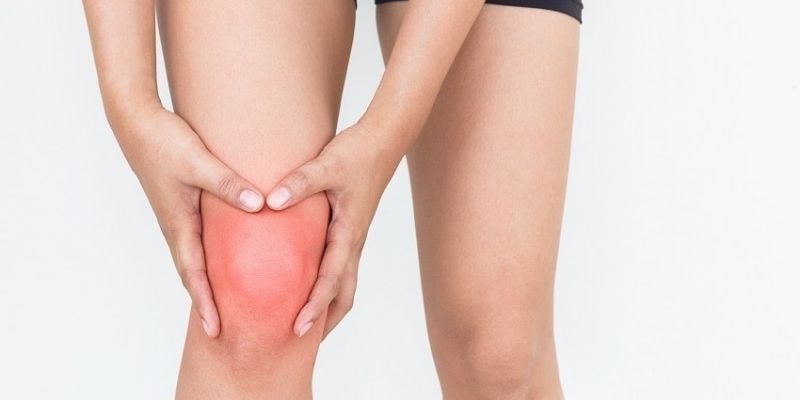
An ACL tear results in immediate knee instability, difficulty bearing weight, and often an audible “pop.” ACL reconstruction surgery may require athletes to return to high-demand activities like golf. Prevention focuses on strengthening the muscles that support the knee joint and improving proprioception through balance training. Proper fitting of golf shoes can also help avoid sudden weight shifts that strain the ACL.
3. Injuries from poor equipment choices or form
Common injuries in golf can also result from equipment choices, swing technique flaws, and poor form.
Back pain from golf clubs that are too long or heavy
Golf clubs that are longer or heavier than needed can strain the golfer’s back during the swing. Clubs that are too long force the golfer to overextend and rotate the trunk more severely to hit the ball properly. With each swing, heavier clubs require more torque from the core and back muscles. Proper club fitting can help select the right length, lie, and weight for a golfer’s physique to minimize back stress.
Wrist pain from gripping the club too tightly
Many golfers grip the club too forcefully, which strains the tendons and ligaments in the wrists and forearms with repetitive swinging. A lighter, less constraining grip allows the wrists to hinge more freely through the swing, reducing friction and tension. Optimal grip pressure should be firm enough to control the club – not squeeze it.
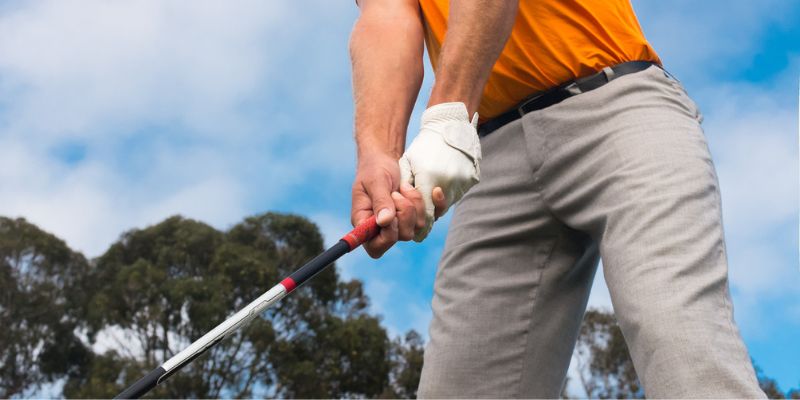
Hip or leg injuries from poor posture, stance flaws, and swing issues
Incorrect posture at address, an improper stance width, and flaws in the hip turn can all injure the hips and legs in golf. Too narrow a stance can overload the inner thigh. An overly vertical posture shifts weight onto the back leg. And a deficient hip turn shifts stress onto muscles not designed for it. Address and swing flaws should be corrected through professional swing evaluation and lessons to avoid strains, tears, and other hip and leg injuries over time.
Prevention strategies
Prevention is always better and safer than cure. Here are some key strategies to prevent common golf injuries:
Proper warm-up and stretching
A full-body warm-up using a resistance band or exercises like arm circles, body twists, and leg swings helps prepare muscles and joints for repetitive golf movements. Stretching key muscle groups like the shoulders, hips, hamstrings, and lower back also increases flexibility and range of motion to reduce injury risk.
Adequate rest between rounds
Golf is a sport of microtrauma – small repetitive stresses that accumulate over time and cause injury. Taking at least one full day off between 18-hole rounds allows time for muscles and joints to recover, reducing the progression to injury.
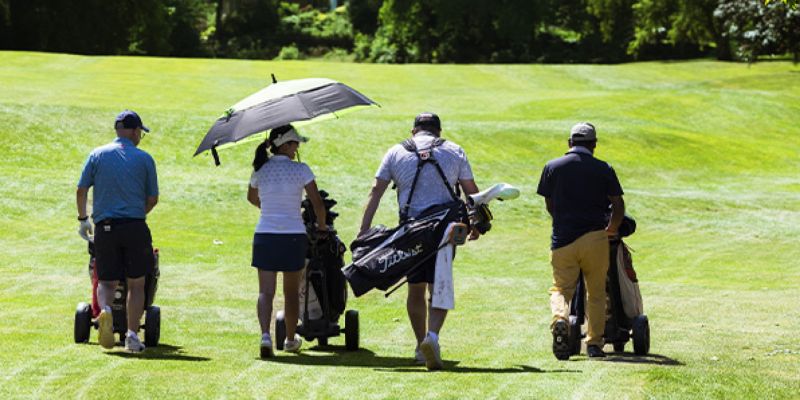
Adjust golf equipment to suit your body.
From club length and lie angle to grip size and golf ball compression, properly fitted equipment can mitigate stress and strain, especially on the back. Getting a club fitting from a professional can optimize your gear to your physique.
Practice good swing techniques and work on your form.
A solid, repeatable golf swing technique that minimizes torque on the body is key to prevention. Common flaws like an overly vertical posture, excessive spine tilt, and over-rotation of the hips and shoulders can lead to injury over time. Lessons from a pro can identify and correct technique flaws before they become problems.
Conclusion
Golf involves repetitive motions and stresses that can lead to overuse injuries and some acute traumatic injuries from missteps or falls. The most common injuries in golf involve golf injuries hand, golf back injuries, shoulders, wrists, elbows, and golf injuries knee. Equipment choices, swing techniques, and overall physical conditioning also play a role in injury risk for golfers.
To help prevent common golf injuries and extend your time on the course, focus on proper warm-up and stretching and follow all tips discussed above. With proper prevention strategies and care for any pains that arise, most golfers can minimize injuries and maximize the game’s enjoyment for many years.